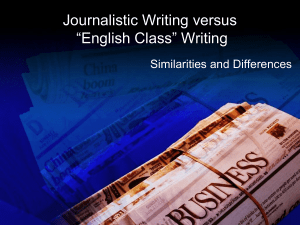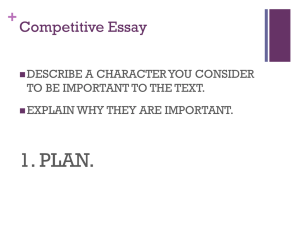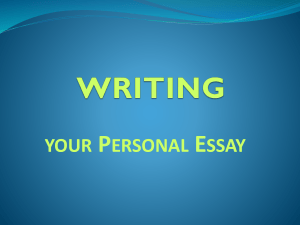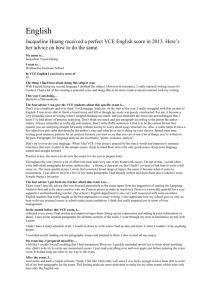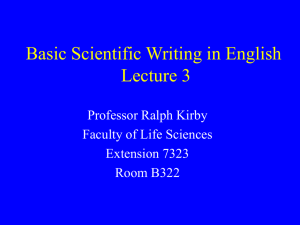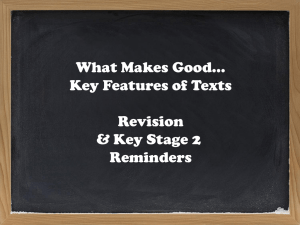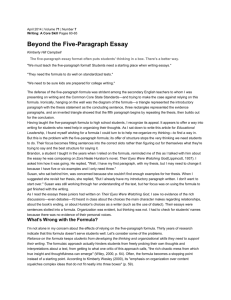Journalistic writing and `English class` writing
advertisement
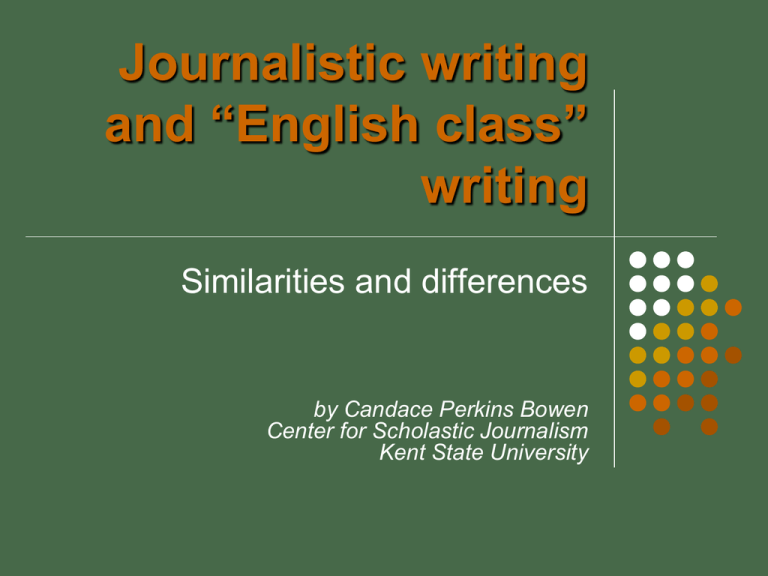
Journalistic writing and “English class” writing Similarities and differences by Candace Perkins Bowen Center for Scholastic Journalism Kent State University Keep these ideas in mind: Each has a different audience. With an English class essay, the writer usually has an audience of one — the teacher. When writing for media, the writer has a much broader audience — the entire school or community. Each has a different purpose. Usually the English essay writer is trying to impress the teacher…and get an A! The journalist needs to clearly and often quickly inform, entertain or persuade an audience. Not all journalistic writing is the same nor is all “English class” writing the same, but consider these general guidelines. Here are some differences… Journalistic writing has short, concise sentences. JW has simple, understandable words. JW uses short paragraphs, often one or two sentences. “English class” writing has longer, more complex sentences. ECW uses more multisyllable words. ECW often has paragraphs of 100 words or more, including a topic sentence and its support. Organization varies… Newswriting is traditionally arranged in an inverted pyramid. The first paragraph is the lead -- with 5Ws and H. A summary lead is usually one sentence. Additional paragraphs are short and contain less and less important information. Essays traditionally are five paragraphs. The first paragraph is the introduction and thesis statement. Second, third and fourth paragraphs develop the topic using Compare and contrast Definition Classification, etc. The final paragraph is the conclusion. Organization Five-Paragraph Essay Inverted pyramid Lead - 5Ws & H Gets less important Intro/Thesis statement Body Conclusion And information-gathering varies, too… Media writing uses lots of primary sources. Interviews with: Experts Spokespersons Newsmakers ‘People on the street’ Secondary sources include: Official records Reference materials Other media Essays often require material from Reading a particular work Drawing on insight and information from previous readings or lectures Applying personal experience But keep in mind why that’s the case: Different audience Different purpose BEWARE OF PLAGIARISM! All writing needs attribution… Media writing works attribution into the context: “The result is dangerous,” Mayor Fred Norton said. According to the Health Commission’s survey, 27 percent of the participants lost weight. This is also necessary when using secondary sources the reporter didn’t interview: “The result is dangerous,” Mayor Fred Norton told the Greenville Times. Essays use various citation forms: MLA APA This could include: Footnotes or endnotes Parenthetical citations Bibliography It’s not quite that simple, but… Not every assignment in English class is a five-paragraph essay. Not every story in the media is a traditional news story. Today’s publications — especially student media — often use news features. These start with a “softer” lead Anecdote Description Suspended interest, etc. Organization varies but generally has An interest-catching beginning A “nut graph” to show the focus An ending that makes it feel “finished” Plenty of short, interesting quotes Transition to tie all the parts together Remember, news and features don’t contain reporter opinion. While all readers would agree, it’s not a “tragic fire.” Without a survey or other way to show this, it’s not accurate to say “everyone owns an iPod.” What is the source? Who researched this? And even if “Greenville High School is better off because she won the award,” the reporter shouldn’t be the one to say it. What IS the same? The basic writing process Brainstorm for ideas Gather information Organize and select appropriate information Write the first draft Share with a coach Use coaching suggestions and insight for second draft Tweak as many times as necessary, polish and submit Good writing is still good writing… But when you become journalists, you have to remember you have A different audience A different purpose And that means leaving some of your English class writing behind.
